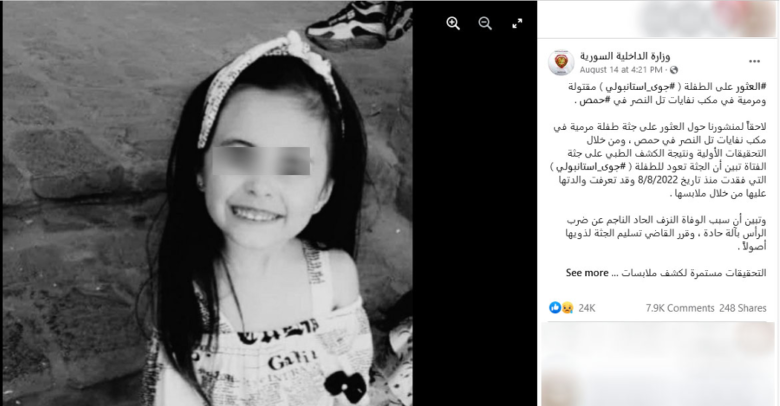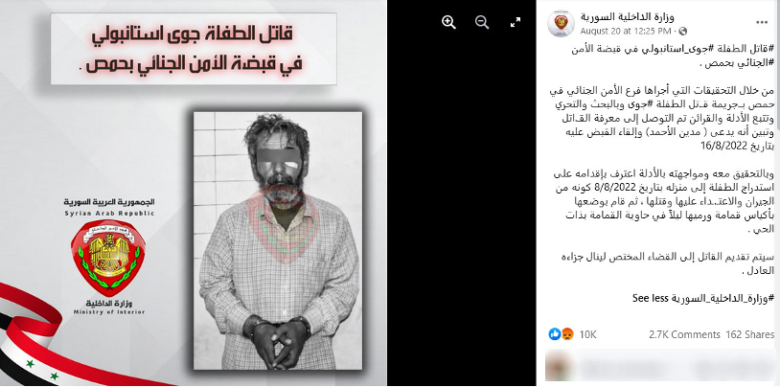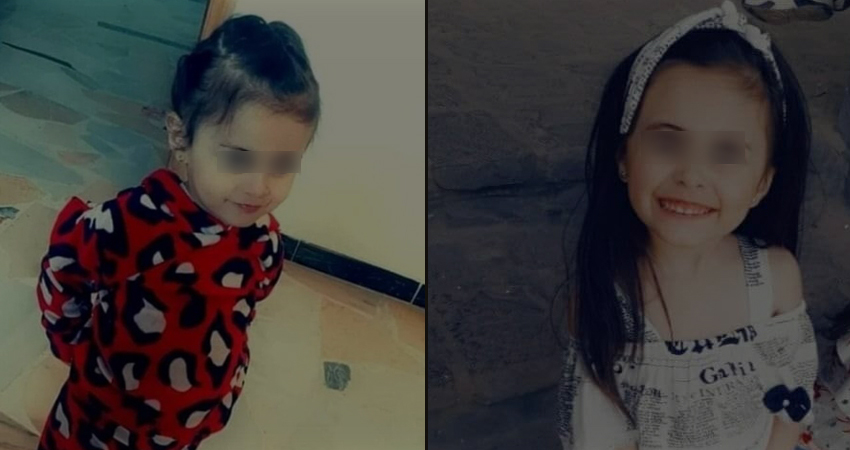Executive Summary
On 14 August 2022, the Ministry of Interior (MoI) published on Facebook that the body of Syrian girl Jawa Istanbouli, who went missing on 08 August 2022, was found in a landfill in Tal al-Nasr in Homs, and that her mother identified her through her clothes. According to the MoI, the cause of death was “severe bleeding caused by hitting the head with a sharp object”. The body was handed over to the family at the request of a judge (his name was not mentioned). The MoI confirmed that investigations were ongoing to uncover the circumstances of the crime and arrest the offender.
On 20 August 2022, the MoI published another announcement that the murderer had been arrested by the Criminal Security Branch in Homs. The post stated that:
“The Criminal Security Branch in Homs searched, investigated, and traced evidence and clues, to find out that the murderer is Madian al-Ahmad. The latter was arrested on 16 August 2022. When interrogating him, al-Ahmad confessed that on 08 August he lured the girl into his apartment, raped and killed her, then put her body in a garbage bag which he later threw in a garbage container in the neighborhood”.

- Image (1) – The Facebook post published by the Ministry of Interior on finding Jawa Istanbouli’s body.

- Image (2) – The Facebook post published by the Ministry of Interior that reveals the identity of the suspect.
Syrians for Truth and Justice (STJ) checked the Facebook posts of the MoI for the last six months and noticed that the MoI usually reveals the initials of the suspect’s name with a photo from behind (to avoid showing the face). However, in Jawa’s case, the full name and photo of the suspect were published publicly, indicating that the government may be intending to use the case to promote its competence, raising doubts about its capacity to apprehend criminals and effectively fulfill its duties in the areas it controls.
The MoI has used the term “murderer” to describe the suspect Madian al-Ahmed. However, this word legally refers to a person who is already declared guilty of a criminal offense by the decision of a judge. This raises questions about the government’s ability to provide a suspect his/her right to a fair trial.
Despite his confession to the police, the accurate legal term to describe al-Ahmad is “the suspect”, which is different from other legal terms. For example, “the defendant” is the one accused by public prosecution of committing a crime, and “the accused” is the one against whom an indictment is issued by a referral or a military investigative judge.
STJ believes that the many mistakes made throughout the government investigation has created widespread doubt about whether the justice has been served and is an example of why the public has little faith in a fair justice system. As this story has caught the attention of many Syrians, in this report, STJ breaks down the miscarriages of justice which have undermined the legitimacy of the investigation.
The Confession of the Suspect Inflames Public Feeling
On 20 August 2022, the MoI published a video of the suspect’s full confession. He narrated: “I lured the girl into my apartment, raped and killed her, then I put her body in a garbage bag which I threw in a garbage container….”.
In the same video, Brigadier General Samer Khattab, head of the Criminal Security Branch in Homs, stated that this crime is unique because the young girl was kidnapped from her own neighborhood (al-Muhajireen) with no evidence of anything/anyone suspicious in the area. Khattab said that despite the search and investigation, no evidence of her whereabouts was found. He added that they searched the suspect’s apartment in the neighborhood and got the name of its owner who had a history of “beating children severely” and having “sexual behavior against nature” (without verifying the validity of these accusations in the first place).
Additionally, Khattab declared that the Criminal Security Branch brought a forensic pathologist to thoroughly inspect the place. Traces of a sexual assault were found. Therefore, the man who was in the apartment was arrested and taken to the Branch where he admitted the following:
“On Monday 08 August, I came from the park (al-Muhajireen Park) at 07:00 pm. I went up to my apartment, then went out to the balcony. The shops were open, and the kids were playing. I saw four girls playing with a ball. I had an idea: since I’m alone, I’ll bring a girl to my place… and I raped her…”.
The suspect described the details of the crime and confessed raping the victim for ten minutes before strangling her.
The confession provoked the feelings of the public because it lacked any consideration for the feelings of the victim’s family and the values of the residents of Homs. As a result, residents of the neighborhood where Jawa used to live demonstrated, calling for vengeance and the immediate execution of the suspect.
Since this case garnered public attention, and in order to stop public rage following the broadcast of the confession, the Minister of Interior, Mohamad al-Rahmoun, went to the girl’s family in al-Muhajireen neighborhood, and offered condolences on behalf of President Bashar al-Assad.
Moreover, on 21 August 2022, the MoI published a video of a short interview conducted by official Syrian TV with Minister al-Rahmoun. The latter stated that there was a tendency (probably by Syrian President Bashar al-Assad) to rapidly uncover the circumstances of the crime and arrest the perpetrator. The minister apologized to Syrians for broadcasting the interview that provoked people. He mentioned that the aim of this act was to reveal the truth about the perpetrator, whom he described as a “human wolf”.
Furthermore, the minister said that the victim’s body was transported in a garbage truck, and as a result, the body was crushed and damaged. Therefore, that the girl was killed by a strike on the head is unconfirmed. He added that the forensic pathologist noticed a wound on the head, and thus, he suspected that the victim had been struck.
STJ believes that the competence of the forensic team is rendered suspect after this statement, particularly as the body was damaged.
The Confession of the Suspect Contradicts the Initial Forensic Report
There is a contradiction between the suspect’s testimony and the initial report of the Preliminary Committee for Forensic Medicine in Homs.
On 21 August 2022, the Director-General of the Syrian Forensic Medicine Authority, Dr. Zaher Hajjo, made a statement to Athr Press (which often aligns with the Syrian government). He stated:
“To prepare the statements, the Forensic Medicine Authority relies on the reports of the examining doctor or committee. (In this case) the initial report could neither confirm nor deny the sexual assault and the cause of death. These two issues were controversial”.
He added:
“When we were informed of the incident, and the medical committee submitted its report to us, our initial statement, similar to the report, neither confirmed nor denied the sexual assault. The reason is that the committee did not perform an autopsy. If an autopsy had been conducted, the situation would have been different”.
On the same day, Hajjo appeared in an interview with Sham FM TV. He confirmed his statement to Athr Press and announced the resignation of the head of the Forensic Medicine Center in Homs, Dr. George Salibi. According to sources aligned with the Syrian government, Dr. Salibi was known for his professionalism and enjoyed a good reputation for more than 20 years. Hajjo explained that this resignation came as a result of the errors in the initial forensic report. He also narrated:
“As the Forensic Medicine Authority, we admit the major errors of the initial forensic report on the death of the girl Jawa. It included two main issues that were controversial, namely the cause of death and the sexual assault”.
In his justification, Hajjo said:
“The committee was confused by the extensive fracture of the skull, expecting it to be caused by a hit on the head that led to death. The result changed after the body was extracted and an autopsy was performed. Now it is confirmed that a sexual assault had taken place”.
Finally, Hajjo indicated that this information was not announced earlier for confidentiality reasons.
STJ’s Comment on the Contradictions between the Initial Forensic Report and the Confession of the Suspect:
The haste in broadcasting the confession played with people’s feelings and proved the lack of concern about the public opinion. This is particularly evident in changing the results of the initial forensic report, the resignation of the doctor who prepared it, and its contradiction with the confession of the suspect.
Moreover, STJ believes that the resignation (or the removal) of Dr. Salibi is just a cover for the government’s mistake. It seems that the MoI decided to interfere in the results of the forensic report to keep it consistent with the government’s narrative.
STJ believes that it is inconsistent to imagine that Dr. Salibi, who is known for his efficiency, credibility, and experience, made such medical errors, such as deciding not to perform an autopsy or to check whether sexual assault had occurred.
Based on the existence of several contradictions, the immediate arrest of the offender, the broadcast of his confession, and the public revelation of his identity, STJ believes it is possible that the government needed to find a scapegoat to arrest, in order to close the case or hide the real perpetrator (although STJ cannot ignore the possibility that al-Ahmad might be the offender).
Several questions still need to be answered: Should we believe the initial forensic report, which states that the death happened as a result of hitting the head with a sharp object? Or the confession of the suspect that he strangled the victim? Is the Forensic Medicine Authority incapable of finding the cause of death? Did the offender rape the victim for ten minutes as he confessed? Or did no sexual assault take place as the report claimed?
The Legal Validity of Confessing before the Criminal Security Branch
In theory, a confession before a security or police officer is not accepted as evidence, unless it is supported by another confession before the court, or consistent with other evidence. Article 176 of the Syrian Criminal Procedure Code, Law No. 112 of 1950, stipulates that “A judge may accept only the evidence presented during a trial and openly discussed by litigants”.
In addition, the jurisprudence does not give a confession before security or police officers the power of proof, unless accompanied by other evidence that supports and proves it[1].
Moreover, Article 180 of the Syrian Criminal Procedure Code states that the confession before law enforcement officials has no legal value and is considered as general information. However, according to Article 175(1), a confession before a judiciary (the Criminal Court, for example), like all other evidence, is subject to the discretion of the judge.
Accordingly, no judgment can be based on a confession before the security services or the police.
Unlike civil cases, a confession in a criminal case has less importance than other evidence. However, in practice, many convictions are based on initial confessions, and courts frequently state that “the denial of the accused, and the retraction of their statement, are nothing but a desperate attempt to evade criminal responsibility”.
In addition, the legislation gives criminal judges the authority to validate evidence. Article 175(1) of the Syrian Criminal Procedure Code states that “evidence in a criminal judiciary can be established by all means of proof, and judges should reach the verdict according to their personal conviction”. Judges may be convinced of any evidence mentioned in a case file and have the power to ignore the rest of evidence, provided that they justify their act.
Legal Problems of Publishing the Photos and Names of Suspects
Some legal experts consider that publishing a suspect’s confession, and revealing their identity, violates Article 410 of the General Penal Code No. 148 of 1949, which prohibits the publication of any document related to an investigation of felony or misdemeanor, unless it is already discussed in a public court session.
Publishing a confession of a suspect in a murder, may lead to rage and vengeance. Article 12 of the Legislative Decree No. 108 of 2011 on Media Law, prohibits the media from publishing any content amounting to an incitement to commit murder, or what is prohibited by the General Penal Code.
Despite the fact that there is no legal obligation on the Criminal Security Branch in Homs to hide the results of the investigation, it is expected that the branch does the utmost to protect the people and avoid revenge, which corresponds to the rule “preventing harms takes precedence over bringing benefits”. In addition, revealing the name of the suspect may affect the evidence or damage it.
On the other hand, other legal experts believe that it is legally acceptable to publish the confession of the suspect in order to preserve the prestige of the agencies that fight crimes, and to restore people’s confidence, especially when no judicial procedure has started. The judiciary takes control of the case only after the necessary steps are handled by a public prosecutor based on the forensic report that confirms the occurrence of a crime.
The notion of a fair trial includes the guarantee of a fair hearing. Fairness of proceedings entails the absence of any direct or indirect influence, pressure, intimidation, or intrusion from whatever side and for whatever motive. A hearing is not fair if, for instance, the defendant in criminal proceedings is faced with the expression of a hostile attitude from the public or support for one party in the courtroom that is tolerated by the court, thereby impinging on the right to defense, or is exposed to other manifestations of hostility with similar effects.
The aforementioned articles (Article 410 of the General Penal Code and Article 12 of the Media Law) reflect the notion of fair trial, which is also mentioned in Article 14 of the International Covenant on Civil and Political Rights. The sitting of every court of justice shall be public. However, courts have the power to exclude all or part of the public for reasons of morals, public order, or national security in a democratic society, or when the interest of the private lives of the parties so requires[2]. This approach puts the interest of justice before the interests of victims[3].
The family of the victim aims to reach justice, by revealing the truth, and holding the real perpetrator accountable. However, their case was used to achieve direct or indirect political interests.
Everyone charged with a criminal offense shall have the right to be presumed innocent until proven guilty according to law. The presumption of innocence is fundamental to the protection of human rights. It is a duty for all public authorities to refrain from prejudging the outcome of a trial, e.g. by abstaining from making public statements affirming the guilt of the accused.[4] Furthermore, Article 14(3)(b) of the International Covenant on Civil and Political Rights states that everyone charged with a criminal offense shall be entitled to “have adequate time and facilities for the preparation of his defense and to communicate with counsel of his own choosing”. In al-Ahmad’s case, the period between the authorities’ announcement of the crime on (14 August) and the broadcast of the confession (on 20 August), cannot be considered “adequate time and facilities” for the accused who is already condemned by a non-judicial authority.
STJ agrees with the first opinion, that the video should not have been published before a verdict was announced by a judge, especially since evidence may now be lost or damaged. Moreover, legal provisions should be respected and obeyed —no exception shall apply unless established by law.
[1] Case No. 49, Primary Court, 56. Dated on 09 June 1985. The Lawyers Magazine. 1987. (p. 1146), Courts Judgment.
[2] UN Human Rights Committee, General Comment No. 32: Article 14 – Right to equality before courts and tribunals and to a fair trial, 23 August 2007, CCPR/C/GC/32, para. 29. Available at: https://digitallibrary.un.org/record/606075?ln=en
[3] UN Human Rights Committee, General Comment No. 32: Article 14 – Right to equality before courts and tribunals and to a fair trial, 23 August 2007, CCPR/C/GC/32, para. 25. Available at: https://digitallibrary.un.org/record/606075?ln=en
[4] UN Human Rights Committee, General Comment No. 32: Article 14 – Right to equality before courts and tribunals and to a fair trial, 23 August 2007, CCPR/C/GC/32, para. 30. Available at: https://digitallibrary.un.org/record/606075?ln=en

